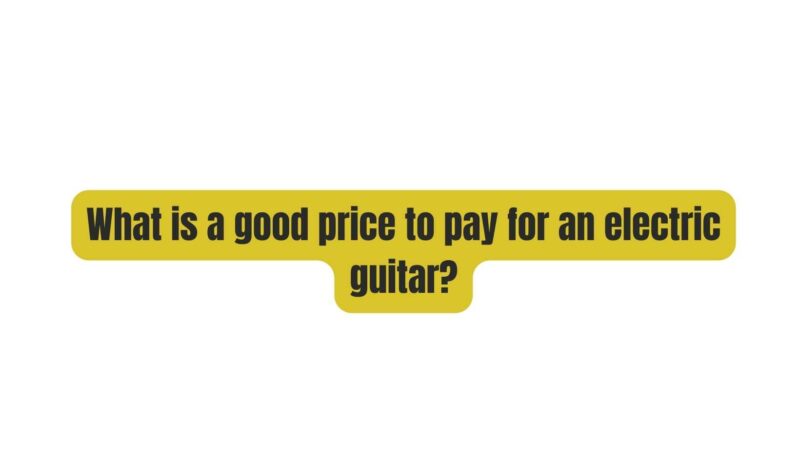The allure of the electric guitar is undeniable, beckoning enthusiasts from all corners of the musical world. Whether you’re an aspiring rock star, a blues aficionado, or just someone eager to make beautiful music, the choice to invest in an electric guitar is a significant one. But what is the right price to pay for an electric guitar? With options ranging from budget-friendly models to high-end masterpieces, navigating the world of electric guitars requires careful consideration. In this article, we’ll explore the factors that determine what constitutes a good price for an electric guitar and provide valuable insights to help you make an informed decision.
I. Understanding the Price Range
To begin our discussion, let’s establish a framework by understanding the different price ranges for electric guitars:
- Budget Range: Electric guitars in the budget range typically cost between $100 to $500. These instruments are ideal for beginners, students, and those on a tight budget.
- Mid-Range: Mid-range electric guitars fall within the $500 to $1,000 range. They offer better build quality, components, and overall performance, making them suitable for intermediate players.
- Premium Range: Premium electric guitars are priced above $1,000 and can extend to several thousand dollars. These guitars are crafted with precision, feature high-quality materials, and are favored by professional musicians.
II. The Pros and Cons of Budget Electric Guitars
Budget electric guitars have their advantages and drawbacks:
- Advantages:
- Affordability: Budget electric guitars are accessible to a wide range of players, making them an excellent starting point for beginners.
- Learning Tool: They serve as valuable learning tools for novice players who want to develop their skills without a substantial financial investment.
- Customization: Many budget models allow players to experiment with modifications, such as upgrading pickups or hardware.
- Drawbacks:
- Build Quality: Budget guitars may have limitations in terms of build quality, leading to potential issues like uneven fretwork or less durable hardware.
- Sound Quality: While they can sound decent, budget guitars may not produce the same level of tonal richness and clarity as higher-end models.
III. Mid-Range Electric Guitars: Striking a Balance
Mid-range electric guitars offer a balance between affordability and quality:
- Advantages:
- Better Quality Components: These guitars feature improved hardware, pickups, and construction, resulting in enhanced playability and sound quality.
- Versatility: Mid-range guitars can handle a wide range of playing styles and genres, making them suitable for diverse musical preferences.
- Drawbacks:
- Cost: They are pricier than budget models, which may be a consideration for those on a tight budget.
IV. Premium Electric Guitars: The Pinnacle of Craftsmanship
Premium electric guitars are known for their exceptional quality and performance:
- Advantages:
- Top-Notch Craftsmanship: These guitars are crafted with precision and premium materials, ensuring excellent build quality and longevity.
- Tonal Excellence: Premium models often produce rich, nuanced tones and provide a superior playing experience.
- Drawbacks:
- High Cost: The primary drawback is the high price tag, which can be prohibitive for many players.
- Maintenance Costs: High-end guitars may require specialized maintenance and repairs, which can be costly.
V. Factors Influencing Price
Several factors influence the price of an electric guitar:
- Brand Reputation: Well-established brands often command higher prices due to their reputation for quality and innovation.
- Materials: The choice of tonewoods, hardware, and electronics significantly impacts the cost of a guitar.
- Craftsmanship: The level of craftsmanship, including attention to detail and quality control, affects the final price.
- Features: Guitars with advanced features, such as custom pickups, unique finishes, or intricate inlays, tend to cost more.
VI. Finding the Right Balance
Choosing the right price for an electric guitar depends on your budget, playing level, and musical aspirations:
- Beginners: Budget guitars in the $100 to $500 range are ideal for beginners who are still exploring their musical interests.
- Intermediate Players: Intermediate players looking for a balance between quality and affordability will find mid-range guitars in the $500 to $1,000 range suitable.
- Advanced Players: Professional musicians and advanced players may opt for premium guitars above $1,000 to meet their specific needs and performance standards.
VII. Conclusion: The Value of Your Musical Journey
In conclusion, the right price to pay for an electric guitar depends on your individual circumstances and goals. Your budget, playing level, and musical preferences all play a significant role in determining the ideal price range. While budget electric guitars provide an excellent starting point, mid-range models strike a balance between affordability and quality, and premium guitars offer the pinnacle of craftsmanship and performance.
Ultimately, the value of an electric guitar extends beyond its price tag. It’s about the music you create, the inspiration it brings, and the passion you invest in your musical journey. Whether you’re strumming chords in your bedroom, playing on stage, or recording in a studio, the right electric guitar should be an instrument that resonates with your soul and allows you to express yourself as a musician. Invest in the guitar that best suits your needs, and let your love for music guide you on a fulfilling and exciting musical adventure.


